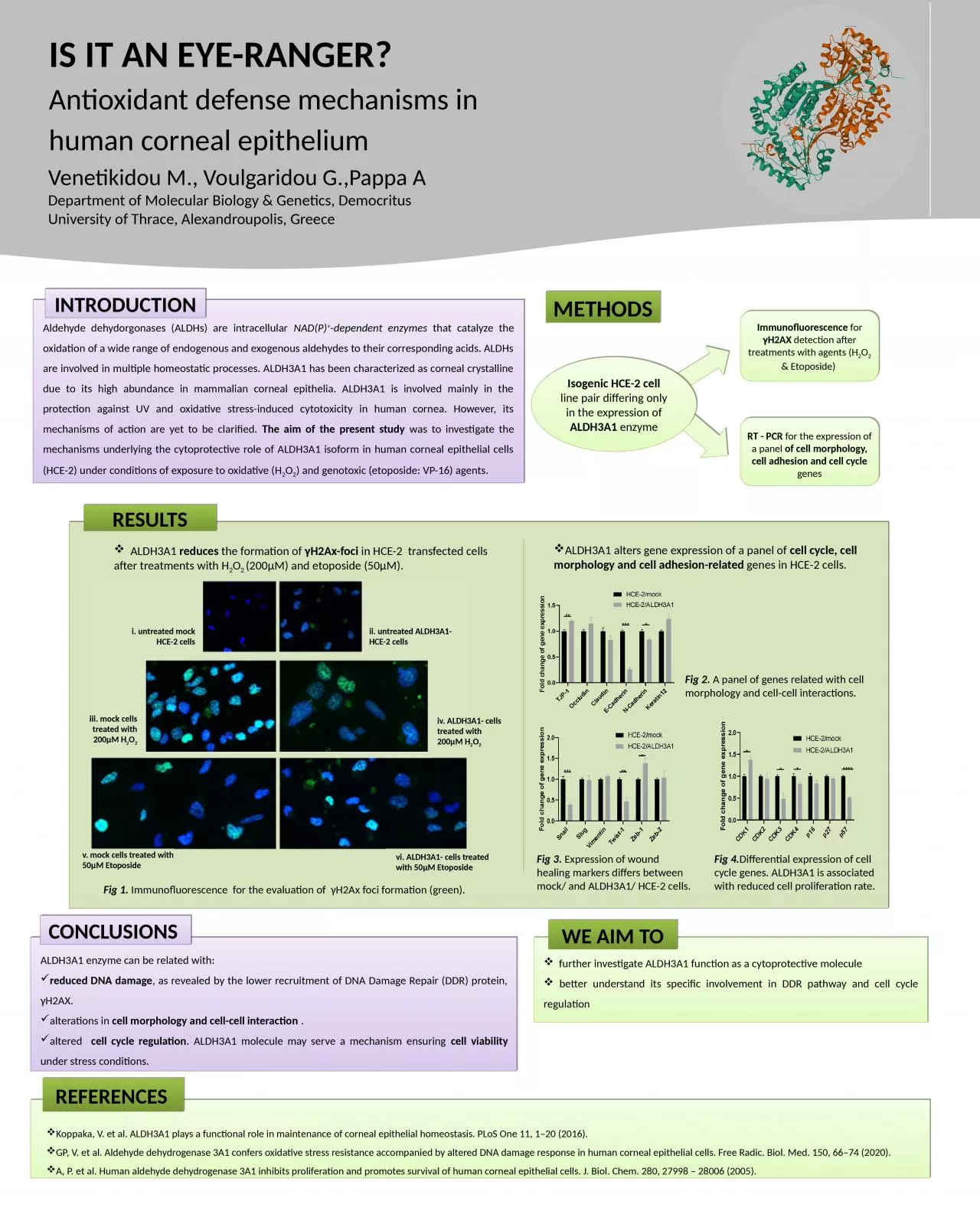

human corneal epithelium Venetikidou M Voulgaridou G Pappa A Department of Molecular Biology amp Genetics Democritus University of Thrace Alexandroupolis ID: 1036997
Download Presentation The PPT/PDF document "IS IT AN EYE-RANGER? Antioxidant defens..." is the property of its rightful owner. Permission is granted to download and print the materials on this web site for personal, non-commercial use only, and to display it on your personal computer provided you do not modify the materials and that you retain all copyright notices contained in the materials. By downloading content from our website, you accept the terms of this agreement.
1. IS IT AN EYE-RANGER? Antioxidant defense mechanisms in human corneal epithelium Venetikidou M., Voulgaridou G.,Pappa A Department of Molecular Biology & Genetics, Democritus University of Thrace, Alexandroupolis, Greece Aldehyde dehydorgonases (ALDHs) are intracellular NAD(P)+-dependent enzymes that catalyze the oxidation of a wide range of endogenous and exogenous aldehydes to their corresponding acids. ALDHs are involved in multiple homeostatic processes. ALDH3A1 has been characterized as corneal crystalline due to its high abundance in mammalian corneal epithelia. ALDH3A1 is involved mainly in the protection against UV and oxidative stress-induced cytotoxicity in human cornea. However, its mechanisms of action are yet to be clarified. The aim of the present study was to investigate the mechanisms underlying the cytoprotective role of ALDH3A1 isoform in human corneal epithelial cells (HCE-2) under conditions of exposure to oxidative (H2O2) and genotoxic (etoposide: VP-16) agents.INTRODUCTIONMETHODSALDH3A1 alters gene expression of a panel of cell cycle, cell morphology and cell adhesion-related genes in HCE-2 cells.RESULTS ALDH3A1 reduces the formation of γH2Ax-foci in HCE-2 transfected cells after treatments with H2O2 (200μΜ) and etoposide (50μΜ). ALDH3A1 enzyme can be related with:reduced DNA damage, as revealed by the lower recruitment of DNA Damage Repair (DDR) protein, γH2AX.alterations in cell morphology and cell-cell interaction . altered cell cycle regulation. ALDH3A1 molecule may serve a mechanism ensuring cell viability under stress conditions. CONCLUSIONS further investigate ALDH3A1 function as a cytoprotective molecule better understand its specific involvement in DDR pathway and cell cycle regulation WE AIM TOFig 1. Immunofluorescence for the evaluation of γH2Ax foci formation (green).Fig 3. Expression of wound healing markers differs between mock/ and ALDH3A1/ HCE-2 cells.Fig 2. A panel of genes related with cell morphology and cell-cell interactions. Fig 4.Differential expression of cell cycle genes. ALDH3A1 is associated with reduced cell proliferation rate. i. untreated mock HCE-2 cellsii. untreated ALDH3A1- HCE-2 cellsiii. mock cells treated with 200μM H2O2v. mock cells treated with 50μM Etoposidevi. ALDH3A1- cells treated with 50μM Etoposideiv. ALDH3A1- cells treated with 200μM H2O2Koppaka, V. et al. ALDH3A1 plays a functional role in maintenance of corneal epithelial homeostasis. PLoS One 11, 1–20 (2016).GP, V. et al. Aldehyde dehydrogenase 3A1 confers oxidative stress resistance accompanied by altered DNA damage response in human corneal epithelial cells. Free Radic. Biol. Med. 150, 66–74 (2020).A, P. et al. Human aldehyde dehydrogenase 3A1 inhibits proliferation and promotes survival of human corneal epithelial cells. J. Biol. Chem. 280, 27998 – 28006 (2005).REFERENCES Immunofluorescence for γΗ2ΑΧ detection after treatments with agents (H2O2 & Etoposide) RT - PCR for the expression of a panel of cell morphology, cell adhesion and cell cycle genesIsogenic HCE-2 cell line pair differing only in the expression of ALDH3A1 enzyme